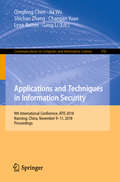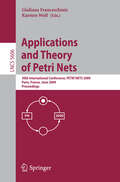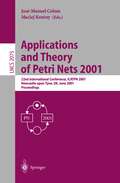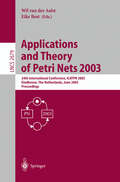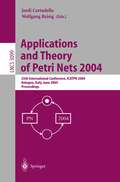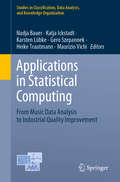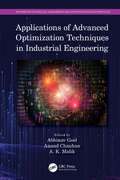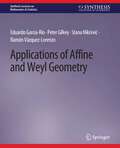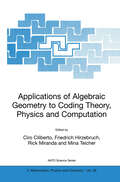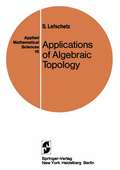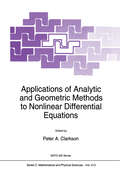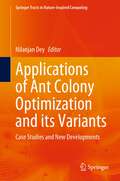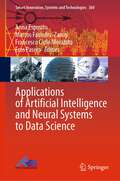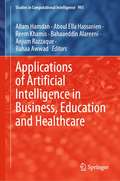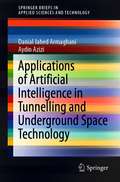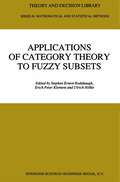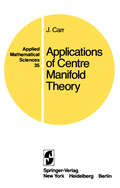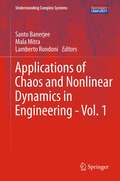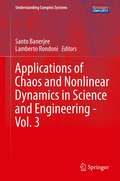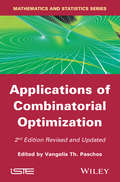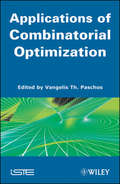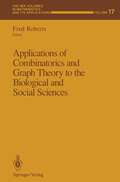- Table View
- List View
Applications and Techniques in Information Security: 9th International Conference, ATIS 2018, Nanning, China, November 9–11, 2018, Proceedings (Communications in Computer and Information Science #950)
by Qingfeng Chen Jia Wu Shichao Zhang Changan Yuan Lynn Batten Gang LiThis book constitutes the refereed proceedings of the 9th International Conference on Applications and Techniques in Information Security, ATIS 2018, held in Nanning, China, in November 2018. The 19 full papers were carefully reviewed and selected from 59 submissions. The papers are organized in the following topical sections: information security, information abuse prevention, security implementations, knowledge discovery, and applications.
Applications and Theory of Petri Nets: 30th International Conference, PETRI NETS 2009, Paris, France, June 22-26, 2009, Proceedings (Lecture Notes in Computer Science #5606)
by Giuliana Franceschinis Karsten WolfThis book constitutes the refereed proceedings of the 30th International Conference on Applications and Theory of Petri Nets and Other Models of Concurrency, PETRI NETS 2009, held in Paris, France, in June 2009. The 19 revised papers classified as theory papers (13), application papers (1), and tool papers (5) were carefully reviewed and selected from 46 submissions. All current issues on research and development in the area of Petri nets and related models of concurrent systems are addressed, novel tools as well as substantial enhancements to existing tools are presented.
Applications and Theory of Petri Nets 2001: 22nd International Conference, ICATPN 2001 Newcastle upon Tyne, UK, June 25-29, 2001 Proceedings (Lecture Notes in Computer Science #2075)
by Jose-Manuel Colom Maciej KoutnyThis volume contains the proceedings of the 22nd International Conference on Application and Theory of Petri Nets. The aim of the Petri net conferences is to create a forum for discussing progress in the application and theory of Petri nets. Typically, the conferences have 100{150 participants { one third of these coming from industry while the rest are from universities and research institutions. The conferences always take place in the last week of June. This year the conference was organized jointly with the 2nd International Conference on Application of Concurrency to System Design (ICACSD 2001). The two conferences shared the invited lectures and the social program. The conference and a number of other activities are co-ordinated by a steering committee with the following members: G. Balbo (Italy), J. Billington (Aust- lia), G. De Michelis (Italy), C. Girault (France), K. Jensen (Denmark), S. - magai (Japan), T. Murata (USA), C.A. Petri (Germany; honorary member), W. Reisig (Germany), G. Rozenberg (The Netherlands; chairman), and M. Silva (Spain). Other activities before and during the 2001 conference included tool dem- strations, a meeting on \XML Based Interchange Formats for Petri Nets", - tensive introductory tutorials, two advanced tutorials on \Probabilistic Methods in Concurrency" and \Model Checking", and two workshops on \Synthesis of Concurrent Systems" and \Concurrency in Dependable Computing". The tu- rial notes and workshop proceedings are not published in these proceedings, but copies are available from the organizers.
Applications and Theory of Petri Nets 2003: 24th International Conference, ICATPN 2003, Eindhoven, The Netherlands, June 23-27, 2003, Proceedings (Lecture Notes in Computer Science #2679)
by Wil Van Der Aalst Eike BestThe refereed proceedings of the 24th International Conference on Applications and Theory of Petri Nets, ICATPN 2003, held in Eindhoven, The Netherlands, in June 2003. The 25 revised full papers presented together with 6 invited contributions were carefully reviewed and selected from 77 submissions. All current issues on research and development in the area of Petri nets are addressed, in particular concurrent systems design and analysis, model checking, networking, business process modeling, formal methods in software engineering, agent systems, systems specification, systems validation, discrete event systems, protocols, and prototyping.
Applications and Theory of Petri Nets 2004: 25th International Conference, ICATPN 2004, Bologna, Italy, June 21-25, 2004, Proceedings (Lecture Notes in Computer Science #3099)
by Jordi Cortadella Wolfgang ReisigApplications in Statistical Computing: From Music Data Analysis to Industrial Quality Improvement (Studies in Classification, Data Analysis, and Knowledge Organization)
by Nadja Bauer Katja Ickstadt Karsten Lübke Gero Szepannek Heike Trautmann Maurizio VichiThis volume presents a selection of research papers on various topics at the interface of statistics and computer science. Emphasis is put on the practical applications of statistical methods in various disciplines, using machine learning and other computational methods. The book covers fields of research including the design of experiments, computational statistics, music data analysis, statistical process control, biometrics, industrial engineering, and econometrics. Gathering innovative, high-quality and scientifically relevant contributions, the volume was published in honor of Claus Weihs, Professor of Computational Statistics at TU Dortmund University, on the occasion of his 66th birthday.
Applications of Advanced Optimization Techniques in Industrial Engineering (Information Technology, Management and Operations Research Practices)
by Abhinav Goel Anand Chauhan A. K. MalikThis book provides different approaches used to analyze, draw attention, and provide an understanding of the advancements in the optimization field across the globe. It brings all of the latest methodologies, tools, and techniques related to optimization and industrial engineering into a single volume to build insights towards the latest advancements in various domains. Applications of Advanced Optimization Techniques in Industrial Engineering includes the basic concept of optimization, techniques, and applications related to industrial engineering. Concepts are introduced in a sequential way along with explanations, illustrations, and solved examples. The book goes on to explore applications of operations research and covers empirical properties of a variety of engineering disciplines. It presents network scheduling, production planning, industrial and manufacturing system issues, and their implications in the real world. The book caters to academicians, researchers, professionals in inventory analytics, business analytics, investment managers, finance firms, storage-related managers, and engineers working in engineering industries and data management fields.
Applications of Advanced Optimization Techniques in Industrial Engineering (Information Technology, Management and Operations Research Practices)
by Abhinav Goel Anand Chauhan A. K. MalikThis book provides different approaches used to analyze, draw attention, and provide an understanding of the advancements in the optimization field across the globe. It brings all of the latest methodologies, tools, and techniques related to optimization and industrial engineering into a single volume to build insights towards the latest advancements in various domains. Applications of Advanced Optimization Techniques in Industrial Engineering includes the basic concept of optimization, techniques, and applications related to industrial engineering. Concepts are introduced in a sequential way along with explanations, illustrations, and solved examples. The book goes on to explore applications of operations research and covers empirical properties of a variety of engineering disciplines. It presents network scheduling, production planning, industrial and manufacturing system issues, and their implications in the real world. The book caters to academicians, researchers, professionals in inventory analytics, business analytics, investment managers, finance firms, storage-related managers, and engineers working in engineering industries and data management fields.
Applications of Affine and Weyl Geometry (Synthesis Lectures on Mathematics & Statistics)
by Eduardo García-Río Peter Gilkey Stana Nikčević Ramón Vázquez-LorenzoPseudo-Riemannian geometry is, to a large extent, the study of the Levi-Civita connection, which is the unique torsion-free connection compatible with the metric structure. There are, however, other affine connections which arise in different contexts, such as conformal geometry, contact structures, Weyl structures, and almost Hermitian geometry. In this book, we reverse this point of view and instead associate an auxiliary pseudo-Riemannian structure of neutral signature to certain affine connections and use this correspondence to study both geometries. We examine Walker structures, Riemannian extensions, and Kähler--Weyl geometry from this viewpoint. This book is intended to be accessible to mathematicians who are not expert in the subject and to students with a basic grounding in differential geometry. Consequently, the first chapter contains a comprehensive introduction to the basic results and definitions we shall need---proofs are included of many of these results to make it as self-contained as possible. Para-complex geometry plays an important role throughout the book and consequently is treated carefully in various chapters, as is the representation theory underlying various results. It is a feature of this book that, rather than as regarding para-complex geometry as an adjunct to complex geometry, instead, we shall often introduce the para-complex concepts first and only later pass to the complex setting. The second and third chapters are devoted to the study of various kinds of Riemannian extensions that associate to an affine structure on a manifold a corresponding metric of neutral signature on its cotangent bundle. These play a role in various questions involving the spectral geometry of the curvature operator and homogeneous connections on surfaces. The fourth chapter deals with Kähler--Weyl geometry, which lies, in a certain sense, midway between affine geometry and Kähler geometry. Another feature of the book is that we have tried wherever possible to find the original references in the subject for possible historical interest. Thus, we have cited the seminal papers of Levi-Civita, Ricci, Schouten, and Weyl, to name but a few exemplars. We have also given different proofs of various results than those that are given in the literature, to take advantage of the unified treatment of the area given herein.
Applications of Algebraic Geometry to Coding Theory, Physics and Computation (NATO Science Series II: Mathematics, Physics and Chemistry #36)
by Ciro Ciliberto Friedrich Hirzebruch Rick Miranda Mina TeicherAn up-to-date report on the current status of important research topics in algebraic geometry and its applications, such as computational algebra and geometry, singularity theory algorithms, numerical solutions of polynomial systems, coding theory, communication networks, and computer vision. Contributions on more fundamental aspects of algebraic geometry include expositions related to counting points on varieties over finite fields, Mori theory, linear systems, Abelian varieties, vector bundles on singular curves, degenerations of surfaces, and mirror symmetry of Calabi-Yau manifolds.
Applications of Algebraic Topology: Graphs and Networks. The Picard-Lefschetz Theory and Feynman Integrals (Applied Mathematical Sciences #16)
by S. LefschetzThis monograph is based, in part, upon lectures given in the Princeton School of Engineering and Applied Science. It presupposes mainly an elementary knowledge of linear algebra and of topology. In topology the limit is dimension two mainly in the latter chapters and questions of topological invariance are carefully avoided. From the technical viewpoint graphs is our only requirement. However, later, questions notably related to Kuratowski's classical theorem have demanded an easily provided treatment of 2-complexes and surfaces. January 1972 Solomon Lefschetz 4 INTRODUCTION The study of electrical networks rests upon preliminary theory of graphs. In the literature this theory has always been dealt with by special ad hoc methods. My purpose here is to show that actually this theory is nothing else than the first chapter of classical algebraic topology and may be very advantageously treated as such by the well known methods of that science. Part I of this volume covers the following ground: The first two chapters present, mainly in outline, the needed basic elements of linear algebra. In this part duality is dealt with somewhat more extensively. In Chapter III the merest elements of general topology are discussed. Graph theory proper is covered in Chapters IV and v, first structurally and then as algebra. Chapter VI discusses the applications to networks. In Chapters VII and VIII the elements of the theory of 2-dimensional complexes and surfaces are presented.
Applications of Analytic and Geometric Methods to Nonlinear Differential Equations (Nato Science Series C: #413)
by P. A. ClarksonIn the study of integrable systems, two different approaches in particular have attracted considerable attention during the past twenty years. (1) The inverse scattering transform (IST), using complex function theory, which has been employed to solve many physically significant equations, the `soliton' equations. (2) Twistor theory, using differential geometry, which has been used to solve the self-dual Yang--Mills (SDYM) equations, a four-dimensional system having important applications in mathematical physics. Both soliton and the SDYM equations have rich algebraic structures which have been extensively studied. Recently, it has been conjectured that, in some sense, all soliton equations arise as special cases of the SDYM equations; subsequently many have been discovered as either exact or asymptotic reductions of the SDYM equations. Consequently what seems to be emerging is that a natural, physically significant system such as the SDYM equations provides the basis for a unifying framework underlying this class of integrable systems, i.e. `soliton' systems. This book contains several articles on the reduction of the SDYM equations to soliton equations and the relationship between the IST and twistor methods. The majority of nonlinear evolution equations are nonintegrable, and so asymptotic, numerical perturbation and reduction techniques are often used to study such equations. This book also contains articles on perturbed soliton equations. Painlevé analysis of partial differential equations, studies of the Painlevé equations and symmetry reductions of nonlinear partial differential equations. (ABSTRACT) In the study of integrable systems, two different approaches in particular have attracted considerable attention during the past twenty years; the inverse scattering transform (IST), for `soliton' equations and twistor theory, for the self-dual Yang--Mills (SDYM) equations. This book contains several articles on the reduction of the SDYM equations to soliton equations and the relationship between the IST and twistor methods. Additionally, it contains articles on perturbed soliton equations, Painlevé analysis of partial differential equations, studies of the Painlevé equations and symmetry reductions of nonlinear partial differential equations.
Applications of Ant Colony Optimization and its Variants: Case Studies and New Developments (Springer Tracts in Nature-Inspired Computing)
by Nilanjan DeyThis book explains the basic ideas behind several variants of ant colony optimization (ACO) and shows how they may be used in real-world settings like manufacturing, engineering design, and health care. Marco Dorigo proposed ACO for the first time, and it has been used to solve a variety of optimization problems. This book presents the latest developments of ACO.
Applications of Artificial Intelligence and Neural Systems to Data Science (Smart Innovation, Systems and Technologies #360)
by Anna Esposito Marcos Faundez-Zanuy Francesco Carlo Morabito Eros PaseroThis book provides an overview on the current progresses in artificial intelligence and neural nets in data science. The book is reporting on intelligent algorithms and applications modeling, prediction, and recognition tasks and many other application areas supporting complex multimodal systems to enhance and improve human–machine or human–human interactions. This field is broadly addressed by the scientific communities and has a strong commercial impact since investigates on the theoretical frameworks supporting the implementation of sophisticated computational intelligence tools. Such tools will support multidisciplinary aspects of data mining and data processing characterizing appropriate system reactions to human-machine interactional exchanges in interactive scenarios. The emotional issue has recently gained increasing attention for such complex systems due to its relevance in helping in the most common human tasks (like cognitive processes, perception, learning, communication, and even "rational" decision-making) and therefore improving the quality of life of the end users.
Applications of Artificial Intelligence in Business, Education and Healthcare (Studies in Computational Intelligence #954)
by Aboul Ella Hassanien Allam Hamdan Anjum Razzaque Bahaaeddin Alareeni Reem Khamis Bahaa AwwadThis book focuses on the implementation of Artificial Intelligence in Business, Education and Healthcare, It includes research articles and expository papers on the applications of Artificial Intelligence on Decision Making, Entrepreneurship, Social Media, Healthcare, Education, Public Sector, FinTech, and RegTech. It also discusses the role of Artificial Intelligence in the current COVID-19 pandemic, in the health sector, education, and others. It also discusses the impact of Artificial Intelligence on decision-making in vital sectors of the economy.
Applications of Artificial Intelligence in Tunnelling and Underground Space Technology (SpringerBriefs in Applied Sciences and Technology)
by Danial Jahed Armaghani Aydin AziziThis book covers the tunnel boring machine (TBM) performance classifications, empirical models, statistical and intelligent-based techniques which have been applied and introduced by the researchers in this field. In addition, a critical review of the available TBM performance predictive models will be discussed in details. Then, this book introduces several predictive models i.e., statistical and intelligent techniques which are applicable, powerful and easy to implement, in estimating TBM performance parameters. The introduced models are accurate enough and they can be used for prediction of TBM performance in practice before designing TBMs.
Applications of Category Theory to Fuzzy Subsets (Theory and Decision Library B #14)
by S. E. Rodabaugh Erich Peter Klement Ulrich HöhleThis book has a fundamental relationship to the International Seminar on Fuzzy Set Theory held each September in Linz, Austria. First, this volume is an extended account of the eleventh Seminar of 1989. Second, and more importantly, it is the culmination of the tradition of the preceding ten Seminars. The purpose of the Linz Seminar, since its inception, was and is to foster the development of the mathematical aspects of fuzzy sets. In the earlier years, this was accomplished by bringing together for a week small grou ps of mathematicians in various fields in an intimate, focused environment which promoted much informal, critical discussion in addition to formal presentations. Beginning with the tenth Seminar, the intimate setting was retained, but each Seminar narrowed in theme; and participation was broadened to include both younger scholars within, and established mathematicians outside, the mathematical mainstream of fuzzy sets theory. Most of the material of this book was developed over the years in close association with the Seminar or influenced by what transpired at Linz. For much of the content, it played a crucial role in either stimulating this material or in providing feedback and the necessary screening of ideas. Thus we may fairly say that the book, and the eleventh Seminar to which it is directly related, are in many respects a culmination of the previous Seminars.
Applications of Centre Manifold Theory (Applied Mathematical Sciences #35)
by J. CarrThese notes are based on a series of lectures given in the Lefschetz Center for Dynamical Systems in the Division of Applied Mathematics at Brown University during the academic year 1978-79. The purpose of the lectures was to give an introduction to the applications of centre manifold theory to differential equations. Most of the material is presented in an informal fashion, by means of worked examples in the hope that this clarifies the use of centre manifold theory. The main application of centre manifold theory given in these notes is to dynamic bifurcation theory. Dynamic bifurcation theory is concerned with topological changes in the nature of the solutions of differential equations as para meters are varied. Such an example is the creation of periodic orbits from an equilibrium point as a parameter crosses a critical value. In certain circumstances, the application of centre manifold theory reduces the dimension of the system under investigation. In this respect the centre manifold theory plays the same role for dynamic problems as the Liapunov-Schmitt procedure plays for the analysis of static solutions. Our use of centre manifold theory in bifurcation problems follows that of Ruelle and Takens [57) and of Marsden and McCracken [51).
Applications of Chaos and Nonlinear Dynamics in Engineering - Vol. 1 (Understanding Complex Systems)
by Santo Banerjee, Mala Mitra and Lamberto RondoniChaos and nonlinear dynamics initially developed as a new emergent field with its foundation in physics and applied mathematics. The highly generic, interdisciplinary quality of the insights gained in the last few decades has spawned myriad applications in almost all branches of science and technology—and even well beyond. Wherever quantitative modeling and analysis of complex, nonlinear phenomena is required, chaos theory and its methods can play a key role. This volume concentrates on reviewing the most relevant contemporary applications of chaotic nonlinear systems as they apply to the various cutting-edge branches of engineering. The book covers the theory as applied to robotics, electronic and communication engineering (for example chaos synchronization and cryptography) as well as to civil and mechanical engineering, where its use in damage monitoring and control is explored). Featuring contributions from active and leading research groups, this collection is ideal both as a reference and as a ‘recipe book’ full of tried and tested, successful engineering applications
Applications of Chaos and Nonlinear Dynamics in Science and Engineering - Vol. 3 (Understanding Complex Systems)
by Santo Banerjee and Lamberto RondoniChaos and nonlinear dynamics initially developed as a new emergent field with its foundation in physics and applied mathematics. The highly generic, interdisciplinary quality of the insights gained in the last few decades has spawned myriad applications in almost all branches of science and technology—and even well beyond. Wherever quantitative modeling and analysis of complex, nonlinear phenomena is required, chaos theory and its methods can play a key role. This third volume concentrates on reviewing further relevant contemporary applications of chaotic nonlinear systems as they apply to the various cutting-edge branches of engineering. This encompasses, but is not limited to, topics such fluctuation relations and chaotic dynamics in physics, fractals and their applications in epileptic seizures, as well as chaos synchronization.Featuring contributions from active and leading research groups, this collection is ideal both as a reference and as a ‘recipe book’ full of tried and tested, successful engineering applications.
Applications of Combinatorial Optimization: Applications Of Combinatorial Optimization (2nd Edition)
by Vangelis PaschosCombinatorial optimization is a multidisciplinary scientific area, lying in the interface of three major scientific domains: mathematics, theoretical computer science and management. The three volumes of the Combinatorial Optimization series aim to cover a wide range of topics in this area. These topics also deal with fundamental notions and approaches as with several classical applications of combinatorial optimization. Concepts of Combinatorial Optimization, is divided into three parts: - On the complexity of combinatorial optimization problems, presenting basics about worst-case and randomized complexity; - Classical solution methods, presenting the two most-known methods for solving hard combinatorial optimization problems, that are Branch-and-Bound and Dynamic Programming; - Elements from mathematical programming, presenting fundamentals from mathematical programming based methods that are in the heart of Operations Research since the origins of this field.
Applications of Combinatorial Optimization (Iste Ser.)
by Vangelis Th. PaschosCombinatorial optimization is a multidisciplinary scientific area, lying in the interface of three major scientific domains: mathematics, theoretical computer science and management. The three volumes of the Combinatorial Optimization series aims to cover a wide range of topics in this area. These topics also deal with fundamental notions and approaches as with several classical applications of combinatorial optimization. “Applications of Combinatorial Optimization” is presenting a certain number among the most common and well-known applications of Combinatorial Optimization.
Applications of Combinatorial Optimization (Iste Ser.)
by Vangelis Th. PaschosCombinatorial optimization is a multidisciplinary scientific area, lying in the interface of three major scientific domains: mathematics, theoretical computer science and management. The three volumes of the Combinatorial Optimization series aim to cover a wide range of topics in this area. These topics also deal with fundamental notions and approaches as with several classical applications of combinatorial optimization. Concepts of Combinatorial Optimization, is divided into three parts: - On the complexity of combinatorial optimization problems, presenting basics about worst-case and randomized complexity; - Classical solution methods, presenting the two most-known methods for solving hard combinatorial optimization problems, that are Branch-and-Bound and Dynamic Programming; - Elements from mathematical programming, presenting fundamentals from mathematical programming based methods that are in the heart of Operations Research since the origins of this field.
Applications of Combinatorial Optimization
by Vangelis Th. PaschosCombinatorial optimization is a multidisciplinary scientific area, lying in the interface of three major scientific domains: mathematics, theoretical computer science and management. The three volumes of the Combinatorial Optimization series aims to cover a wide range of topics in this area. These topics also deal with fundamental notions and approaches as with several classical applications of combinatorial optimization. “Applications of Combinatorial Optimization” is presenting a certain number among the most common and well-known applications of Combinatorial Optimization.
Applications of Combinatorics and Graph Theory to the Biological and Social Sciences (The IMA Volumes in Mathematics and its Applications #17)
by Fred RobertsThis IMA Volume in Mathematics and its Applications Applications of Combinatorics and Graph Theory to the Biological and Social Sciences is based on the proceedings of a workshop which was an integral part of the 1987-88 IMA program on APPLIED COMBINATORICS. We are grateful to the Scientific Committee: Victor Klee (Chairman), Daniel Kleitman, Dijen Ray-Chaudhuri and Dennis Stanton for planning and implementing an exciting and stimulating year long program. We especially thank the Workshop Organizers, Joel Cohen and Fred Roberts, for organizing a workshop which brought together many of the major figures in a variety of research fields connected with the application of combinatorial ideas to the social and biological sciences. A vner Friedman Willard Miller APPLICATIONS OF COMBINATORICS AND GRAPH THEORY TO THE BIOLOGICAL AND SOCIAL SCIENCES: SEVEN FUNDAMENTAL IDEAS FRED S. RoBERTS* Abstract. To set the stage for the other papers in this volume, seven fundamental concepts which arise in the applications of combinatorics and graph theory in the biological and social sciences are described. These ideas are: RNA chains as "words" in a 4 letter alphabet; interval graphs; competition graphs or niche overlap graphs; qualitative stability; balanced signed graphs; social welfare functions; and semiorders. For each idea, some basic results are presented, some recent results are given, and some open problems are mentioned.
